Abstract
The formation of ethnic identity factors in childhood are discussed. The lower age limit and the forms of the first manifestations of the ethnic children self-consciousness are established. Theoretical foundations are presented. Methodological tools using in an empirical study of the ethnic identity of preschoolers and primary school age children, the forms of its manifestation and the psychological factors of its development are presented. The structure of ethnic identity is determined in the early stages of its manifestation and the relationship with the intellectual, emotional and social maturation of the child. It has been empirically established that first submissions on an own ethnic group and on oneself as its representative are simplified and significantly related to the level of emotional, intellectual and social maturation of a child. It is shown that these structures in the child’s psyche become information filters from the external environment and provide the formation of an image of himself and his group. The higher the level of their maturation, the more diverse complex of typical features, which a child is capable of reflexing, the richer and more complex understanding of himself and his ethnic group. It is shown that at this stage of age development there is an uncritical perception of their ethnic identity due to imitation and the desire for similarity with their loved ones. It has been established that among the diverse information flow language and national clothes make the greatest contribution to the image formation of their ethnic culture at this age stage.
Keywords: Ethnic identityethnic cultureethno-differentiating markersage dynamics of ethnic identityethnocultural socializationcultural artifacts
Introduction
The problem of ethnic identity is a topic, retaining its relevance throughout the existence of psychological science. This results from the fact that ethnic self-consciousness has a significant impact on behavior in the social space, in which a person is included. Being a mechanism of group affiliation, ethnic identity provides a solution to a whole range of psychological needs: protection, adaptation, orientation in the surrounding space, self-regulation, integration into the structure of social relations. As a product of ethnocultural socialization, ethnic self-consciousness has stages of age development. It is associated with the influence of the social environment, in which the subject is included.
Today at the period of globalization processes the study of ethnic identity formation becomes relevant. First, the attention of researchers is attracted by the question of the ethnic identity formation in the younger generation.
Problem Statement
Fundamental research of the 20th century laid a powerful foundation in understanding the ethnic identity. These are the works of G. Shpet (Shpet, 2014), Yu. V. Bromley (Bromley, 2000), J. Piaget (Piaget, 2006), G. Bruner (Bruner, 1977), and others. Modern studies of ethnic self-consciousness in various contexts of psychological connections and dependencies are presented in the works of I. S. Kon (Kon, 1988), Yu. V. Arutyunyan, L. M. Drobizheva (Arutyunyan, Drobizheva, & Susokolov, 1999), N.M. Lebedeva (Lebedeva, 2011), A. A. Nalchadzhyan (Nalchadzhyan, 2004) and others. A variety of doctoral and candidate studies was depicted to an analysis of ethnic identity aspects. The structure and functions of ethnic identity in (Khotinets, 2000; Stefanenko, 2000; Stefanenko, 2004; Nalchadzhyan, 2004; Avdeeva, 2012; Buchek, 2012), dynamics its development in (Romanova, 1994; Fomina, 2012), external and internal factors of formation in (Nelson, 1986; Goloshumova, Svinina, 2003; Teslenko, 2011; Pankin, 2014), features of manifestation in different nations and different social groups in (Bromley, 2000; Grushevitskaya, Popkov, & Sadokhin, 2002; Lebedeva, 2011) are studied. However, basic research on the manifestations of ethnic identity and psychological factors of its development from the earliest stages of age development have rarely become research subjects (Piaget, 2006; Romanova, 1994).
Research Questions
The research subject is the manifestation features of ethnic identity in children of preschool and primary school age.
The empirical analysis aims to test the hypothesis that the first manifestations of the subject’s ethnic identity relate to the preschool age and at this stage of the age development the manifestations of ethnic identity are related to the level of the child’s cognitive, emotional and social development.
The theoretical basis was the concept of intellectual development by J. Piaget (Piaget, 1992), the theory of social perception by J. Bruner (Bruner, 1977) and the theory of ecological systems by U. Bronfenbrenner (Bronfenbrenner, 1976). In accordance with them, a theoretical model of ethnic identity was built, in which the emotional, cognitive and social structures of the subject play an important role. These structures are presented as filters of information from the external environment; and they create the image of themselves as a representative of their ethnic group (Figure
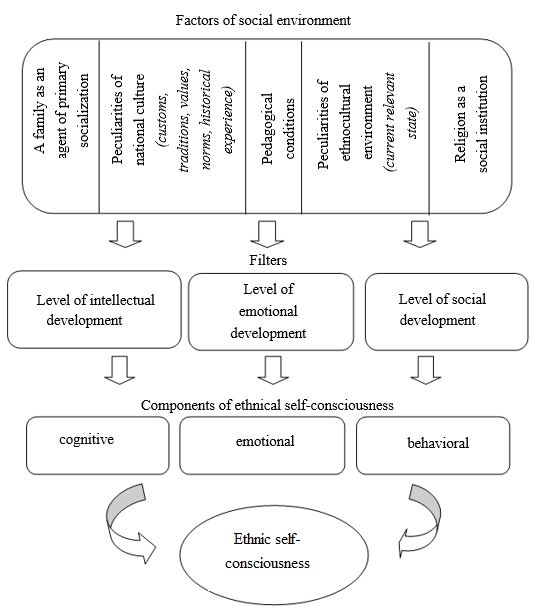
The model illustrates the influence of socializing factors on the constituent components of ethnic identity (cognitive, emotional, behavioral). The formation of these components, in turn, is determined by the development level of the corresponding functions in the structure of the child’s psyche, namely emotional, cognitive and social development. They act as filters through, which information flows from the external environment; and they are transformed into components of ethnic knowledge and identity.
The relationships between the structural elements of the model should be described in detail. According to the theory of the formation of ethnic identity in ontogenesis, proposed by (Piaget, 2006), there are several objective factors affecting the individual in the process of socialization. These factors include family environment, features of national culture, features of the pedagogical conditions, in which a person is in the process of socialization, religion, where each of these factors has its specific content. The level of cognitive development determines the level of knowledge and ideas of a child about his own and other ethnic groups. In addition, the cognitive level is based on the ability to single out essential features and differentiate one ethnic group from another by another, a foreign ethnic group from its own. In our opinion, these skills are based on the development of such functions as the isolation of the essential object features, classification and categorization. Emotional development determines the evaluative component of ethnic identity: own vs foreign, like vs dislike. At this age, the cognitive component of ethnic identity is associated with an understanding of the affiliation of close people to a given ethnic group; and it is due to the desire to be accepted by them and to imitate them. As Bandura, (2000) wrote in the behavioral, social component is directly related to the emotional one and reflects the need in manifestation of himself as a member of an ethnic group. It provides the subject with socially correct behavior in ethnic contact situations.
Accordingly, the higher the level of meaningfulness of the perceived information, the more consciously formed the idea of their own ethnic identity. The lower the level of development of these three components, the more diffuse the nature of ethnic identity.
Further studies of this issue aim at empirical confirmation of the presented model.
Purpose of the Study
The purposes of the study are fundamental and practical:
- to reveal the peculiarities of development manifestation and factors of ethnic self-consciousness in children at the early stages of its formation; to determine the age limits and mechanisms of the formation of ethnic self-consciousness.
- to form the basis for the development of pedagogical education adequate programs, training and practical preparation of young children for life in a multicultural society.
Research Methods
The created theoretical model of the development factors of ethnic self-consciousness in children at the early stages of its formation determined the choice of methodological tools and the nature of the sample.
The sample consisted of representatives of the Crimean Tatar, Russian and Ukrainian nationalities. The total number of children was 76 people. Of these, 37 girls and 39 boys. By age, the sample is distributed as follows: 36 preschoolers aged 4 to 6 years and 40 younger schoolchildren aged 7 to 9 years. The experimental base of the research was Infant school No. 89, Infant school No. 13, and Secondary School No. 33, Secondary School No. 40 in Simferopol, Republic of Crimea.
The study proceeded in several stages: preparatory, ascertaining and final.
At the preparatory stage, theoretical approaches to the analysis of ethnic identity were studied. They formed the basis for the creation of a theoretical research model, and methodological tools were defined.
At the ascertaining stage, the levels of emotional, intellectual and social development in children were investigated. A range of personal identifications and their informative characteristics and a level of awareness about their own and foreign ethnic cultures were studied. The methods used at this stage included diagnostic procedures for various types of intelligence, presented in the collection by G. A. Uruntayeva, Yu. V. Afon’kina, “Who am I?” technique in adaptation by Rumyantseva (Uruntayeva & Afonkina, 1995), the author’s methodology for studying children’s ethnocultural awareness, structured interview programs and content analysis of their materials.
The final stage included a multi-level comparative analysis of the data obtained, which allows statistical methods to identify the relationship of the factors. At this stage, cluster, correlation and analysis of variance were used.
Findings
Emotion as a reflective-estimated, motivating, activating, and regulating force, has a significant impact on the effectiveness of children orientation and adaptation in the surrounding space. A level of emotional intelligence development allows the child to correctly isolate the essence of interpersonal interactions, to characterize their emotional state and the emotional state of another, to comprehend the direction and motivation of their own and others’ actions in the form of a relationship. The study of emotional intelligence in children of preschool and primary school age using the methods of Uruntaeva, and Afonkina (1995) allowed to judge the formation degree of emotional intelligence in children of preschool and primary school age. A testing was carried out in two series. The first series included tasks for differentiation and recognition of basic human emotions. The second series included tasks for the description of the emotional states in the plot pictures, followed by endowing them with cause-and-effect relationships. The results of the analysis of the level formation of children's emotional intelligence are presented below (Figure
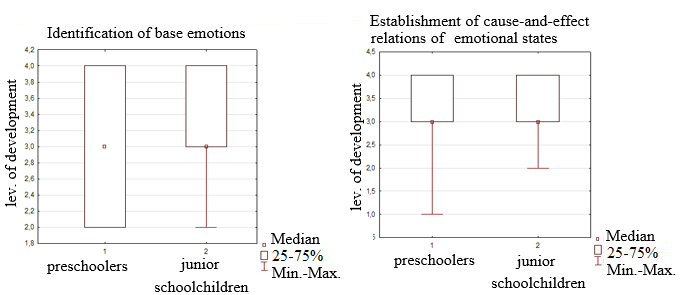
Based on the data obtained, we can say that children of younger school age have a more developed ability to differentiate basic human emotions, which makes it possible to attribute this factor to the prerequisites of the formation of emotional intelligence.
The ability to recognize and reflect on the cause-effect relationships of the emotional states in the context of simple social situations is characteristic of children of senior preschool and primary school age at the same high level.
At the next stage, the subject of analysis was the development level of the social intelligence in children. Because ethnic identity is directly related to the awareness of group membership, a level of social intelligence is necessary for the development and further transformation of ethnic identity. The study of the social intelligence in children of preschool and primary school age was carried out using the research procedure “Social Intellect” by (Uruntayeva & Afonkina, 1995). The test included two series of procedures. In the first series, the child was offered several situations of social interaction, carrying a problem or putting a child in a dilemma situation, and he was asked to give his own solution to this situation. Based on the proposed solutions, the conclusion was made about the formation degree of the basic social representations of the subject. The tasks of the second series made it possible to investigate the formation level of both primary basic concepts and the attitudes towards action in various situations of interaction in society.
It is this feature that reveals the child’s ability to understand the essence of social relationships, to be a participant in these relationships and to effectively adapt to the requirements of society. The data obtained allow to conclude that the formation level of basic social ideas and attitudes is high. They are expressed in the ability to recognize and describe the situation of social interaction between two age groups (Figure
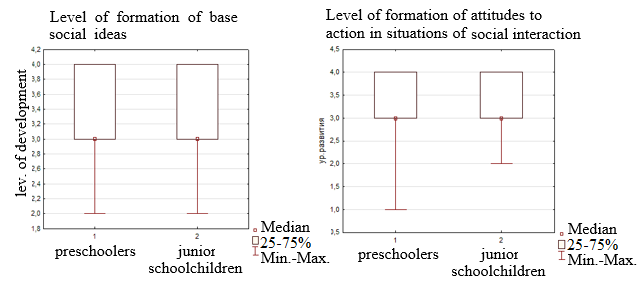
The level of social competence expressed in the analysis of the situation and the readiness to act in situations of social interaction in children of senior preschool age are at the same relatively high level of development as in children of primary school age. The differences between the two groups are minimal.
The next stage of the analysis focused on the intellectual functions of generalization and classification. The formed ability to classify material by isolating the essential features of objects is a prerequisite for recognizing the cultural characteristics of different ethnic groups and their representatives, and to generalize these features as markers of their own and other ethnic groups. The selection of person’s similarity signs and differences with other ethnic groups for the formation of ideas about own and other ethnic groups is a necessary skill for the development of ethnic identity. The study of the development level of intellectual functions was carried out using the “General Intellect” technique of G (Uruntayeva & Afonkina, 1995). The results of a comparative analysis of the two age groups are presented below (Figure
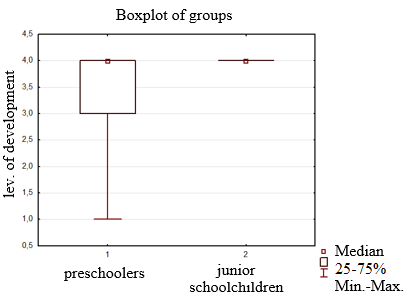
The picture test “Know Your People” is an author’s technique aimed at studying the awareness of an personality about the signs and culture of both his people and others.
The child was given a stimulus material from a series of pictures by categories:
1. Clothes; 2. Kitchen; 3. Life; 4. Architecture.
Such a set of 4 pictures was selected for each of the eight peoples inhabiting the Crimea peninsula: Crimean Tatars, Russians, Ukrainians, Armenians, Azerbaijanis, Jews, Greeks, Bulgarians. The subject was asked to choose a picture in each series that corresponds to the character traits of his people.
The evaluation took place by coding the answer in conditional points: I recognized – 1, I didn’t recognize – 0. By the accumulated points from 4 episodes, we can judge how well the child is oriented in recognizing the native ethnos. This procedure allows the subject to reveal the actual knowledge about the culture of his people and to find out which characterological features of the ethnos are the most recognizable, already firmly assimilated by children of older preschool and primary school age. The diagram below shows that the level of ethnocultural awareness of younger students is significantly higher than that of preschool children (Figure
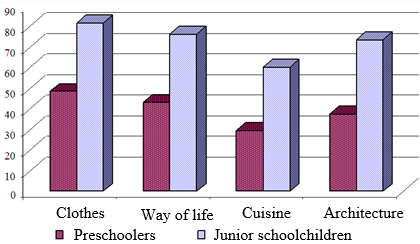
The greatest contribution to the image formation of their ethnic culture at this age stage, in addition to language, is made by the national costume. From our point of view, this is explained by the fact that the national costume is the most striking visual artifact of the people. It is simple for perception and convenient for the processes of differentiation and classification. In comparison, such cultural artifacts as cuisine, life and architecture require greater social and intellectual preparedness.
The interview conducted with the children of the sample studied was aimed at identifying the depth of the child’s awareness of their ethnicity, the degree of meaningfulness of this knowledge and its sources. The interview included 5 main questions:
1) Do you know what nationality are you?
2) How, from whom did you know that you are (nationality)?
3) What do you know about (nationality)?
4) Do you like your (nationality)?
5) What does it mean, in your opinion, to be real ... (nationality)?
The received material was subjected to high-quality processing by content analysis. It should be noted that the categories shown in the graphs (Figure
The study of ethnocultural information sources showed that in the early stages of age development, family, as a primary institution of socialization, plays a leading role in the development of ethnic self-consciousness. Family is the main source of ethnic information for a child (Figure
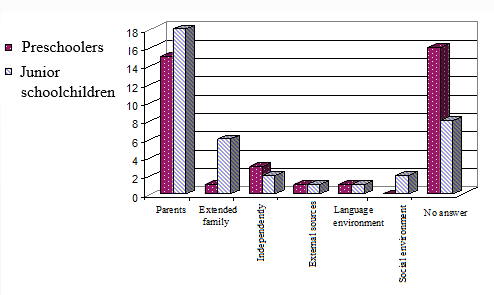
The older the child, the greater his social experience, the greater the quantity and the more varied the quality of ethno-labeling indicators and ethno-differentiating characteristics that he is able to reflect (Figure
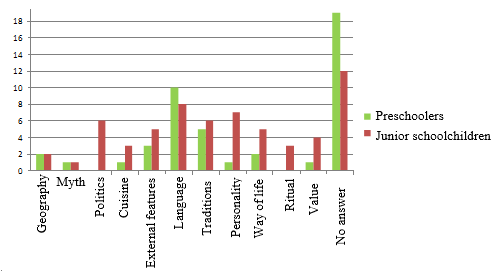
Language, as an ethno-labeling indication, gained the greatest weight in both groups of subjects. The data of our study confirm the conclusions of previous researchers that the language is the main ethno-differentiating feature and a key factor in the formation of the ethnic identity.
The study of the identities complex formed in children of two age groups showed that age, social experience and the general level of intellectual development have a significant impact on the hierarchy of assigned identities (Figure
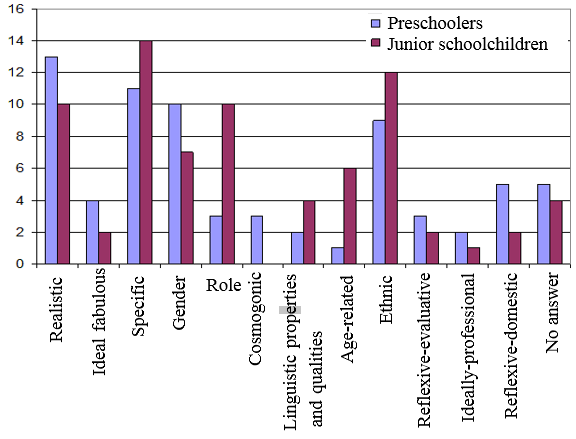
Using statistical methods, the authors succeeded in establishing of the relationship between the studied factors and the components of ethnic identity. Therefore, it was found that the higher the indicator of emotional intelligence is, the greater the degree of ethnic identification is demonstrated by the respondent (Figure
It is important to note that ethnic identity has a degree of severity among the identities assigned to children of preschool age. It should be emphasized that this identity is often not under the emotional rationale, fragmented and simplified, but it is present in the mind of the child. The older the child, the more conscious his attitudes. The structure of ethnic knowledge and self-consciousness becomes more complex. In general, the data allow to conclude that the formation of ethnocultural ideas is not passive, but active in nature. It is due both to the targeted formative influence of the family and to maintaining the traditions of ethnic culture in the family that a child observes, such as in the Crimean Tatars. Statistical methods were able to establish the relationship of the studied factors with the components of ethnic identity. So, it was found that:
1) the higher the indicator of emotional intelligence, the greater the degree of respondent’s ethnic identification (Figure
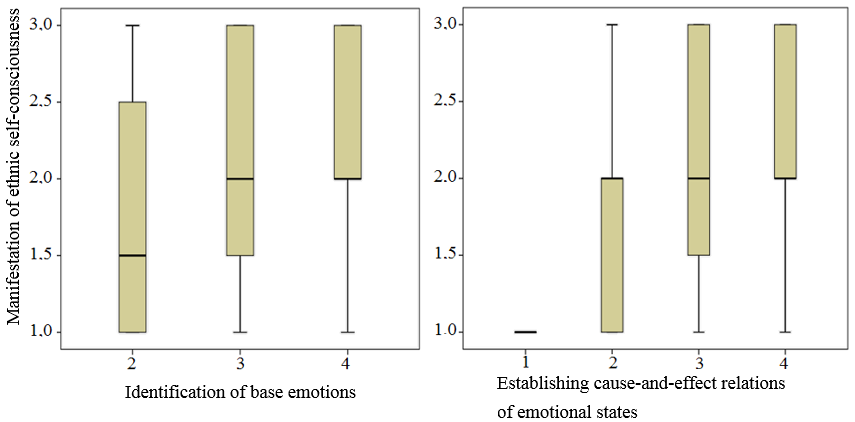
2) the higher the indicator of social intelligence, the greater the degree of ethnic identification (Figure
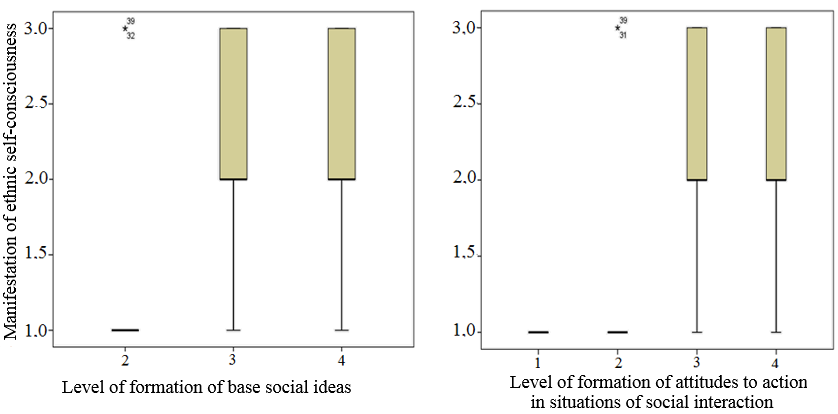
3) the higher the general intelligence indicator, the greater the degree of ethnic identification (Figure
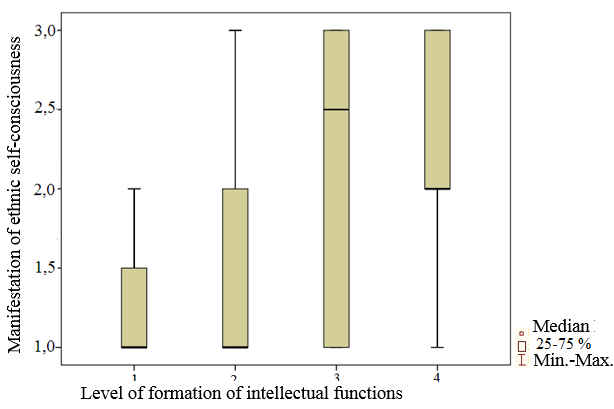
The significance of all links is noted at a level not lower than p <0.01
Completing the analysis, we can say that the formation of cognitive, emotional and social components greatly influences the development of ethnic self-consciousness, which confirms our hypothesis.
Conclusion
Summing up the theoretical and empirical study of ethnic identity phenomenology of children in the early stages of its formation, the following conclusions can be drawn.
Ethnic self-consciousness is an emotional-cognitive process of realizing oneself as a representative of an ethnic group, including the emotional-axiological value attributed to this membership.
The family environment, customs, religious beliefs and ethno-cultural characteristics have an impact on a personality in the process of his socialization. The influence of these factors is refracted through the consciousness of a personality and represented by a certain image of himself as a representative of his group. This image is made up of a cognitive component (who I am, who we are, who are others), an emotional component (how I feel about this) and a behavioral component (how you should act, being a representative of your culture).
Children of primary school age demonstrate a more developed ability to differentiate basic human emotions in comparison with preschoolers. At the same time, the ability to recognize and reflect on the cause-effect relationships of the emotional states in the context of simple social situations that are accessible to the child’s understanding is equally expressed in children of older preschool and primary school age.
A relatively high level of basic social concepts and attitudes has been established, expressed in the ability to recognize and describe the situation of social interaction in both children of primary school age and senior preschool age.
The level of social competence expressed in the analysis of the situation and the attitudes of readiness to act in situations of social interaction in children of senior preschool age is at the same relatively high level of development as in children of primary school age. The differences between the two groups are minimal.
The level of intellectual processes in the structure of general intelligence in children of primary school age significantly exceeds the level of formation of these processes in preschool children.
In the early stages of ethnic self-awareness formation, the family, as the primary institution of socialization, plays a leading role in the development of ethnic self-awareness. It is the main source of ethnic information for children.
The older the child, the greater his social experience, the greater the quantity and the more diverse the quality of ethno-labeling indicators and ethno-differentiating signs.
The leading feature in two age groups is language. The data of our study confirm the conclusions of previous researchers that the language is the main ethno-differentiating feature and a key factor in the formation of the ethnic identity.
In the studied age sample, there was not a single case of negative attitudes about their ethnicity. This confirms the conclusion that at this stage there is an uncritical perception of their ethnic identity due to imitation and desire for similarity with their loved ones.
In addition to language, national clothing makes the greatest contribution to the image of its ethnic culture. This may be explained by the fact that the national costume is the most striking visual artifact of the people, simple to understand and convenient for the processes of differentiation and classification. In comparison, such cultural artifacts as cuisine, life and architecture require greater social and intellectual preparedness.
The study of the identities complex formed in children of two age groups shows that age, social experience and the general level of intellectual development have a significant impact on the hierarchy of identities.
It should be emphasized that ethnic identity has a degree of manifestation among children of preschool age to be fixed. This identity often has no emotional rationale. It is fragmentary and simplified, but it is present in the mind of the child. The older the child, the more conscious his attitudes. The structure of ethnic knowledge and self-consciousness becomes more complex.
The relationship of ethnic identity expression with the level of cognitive, emotional and social maturation of the child was established.
In general, the data allow to conclude that the formation of ethnocultural ideas about oneself and others is not passive but active in nature. It is due both to a targeted forming influence of the family and to a maintaining the traditions of ethnic culture in the family.
Completing the analysis of our research, we can confirm the hypothesis put forward that the ethnic identity of the subject first manifests itself in preschool age and its manifestations are diffuse, fragmented. The main internal factors determining the formation of ethnic identity at this age stage can be called the level of cognitive, emotional and social maturation.
We can confirm the hypothesis that the ethnic identity first manifests itself in preschool age; and its manifestations are diffuse and fragmented. The main internal factors determining the formation of ethnic identity at this age stage can be called the level of cognitive, emotional and social maturation, and the external factors are the purposeful influence of the family and the immediate environment.
References
- Avdeeva, N. N. (2012). The development of ideas about yourself in a child from birth to 7 years. Moscow: Nauka.
- Arutyunyan, Yu. V., Drobizheva, L. M., Susokolov, A. A. (1999). Ethnosociology. Moscow: Aspekt-Press.
- Bandura, A. (2000). Social learning theory. Saint-Petersburg: Evraziya.
- Bromley, Yu. V. (2000). On the issue of ethnic groups allocation among other human communities. In: Prazauskas, А. А. (Ed.) Ethnicity and politics: anthology (pp. 38-59). Moscow: URAO.
- Bronfenbrenner, U. (1976). Two worlds of childhood: Children in the USA and the USSR. Moscow: Progress.
- Bruner, J. (1977). Psychology of knowledge. Outside immediate information. Moscow: Progress.
- Buchek, A. A. (2012). Ethnic identity of the individual in the space of the multi-ethnic world (Monograph). Petropavlovsk-Kamchatsky: KamGU im. Vitusa Beringa.
- Fomina, Yu. I. (2012). On the formation of ethnic ideas. In: Sapogova E. E. Bulletin of Tula State University. Psychology Series, 7, 61-67.
- Goloshumova, G. S., Svinina N. G. (2003). Ethnocultural education of younger students. Primary School, 8, 22-27.
- Grushevitskaya, T. G., Popkov, V. D., Sadokhin, A. P. (2002). Basics of intercultural communication. Moscow: YUNITI-DANA.
- Kon, I. S. (1988). Child and society. Moscow: Nauka.
- Khotinets, V. Yu. (2000). Ethnic identity. Saint-Petersburg: Aleteyya.
- Lebedeva, N. M. (2011). Ethnic and cross-cultural psychology. Moscow: Maks Press.
- Nalchadzhyan, A. A. (2004). Ethnopsychology. Saint-Petersburg: Piter.
- Nelson, K. (1986). Event Knowledge Structure and Function in Development. Hillsdale, New Jersey: Lawrence Erlbaum Associates.
- Pankin, A. B. (2014). Formation of ethnocultural personality. Moscow: MPSI.
- Piaget, J. (1992). Theory of Piaget. Section III: Stage Theory. In: Galperin, P. Ya., Zhdan, A. N. (Eds.) History of foreign psychology (pp. 232-292). Moscow: Texts..
- Piaget, J. (2006). Moral judgments in a child. Moscow: Akademicheskiy Proyekt.
- Romanova, O. L. (1994). The development of ethnic identity in children and adolescents (Dissertation for candidate). Retrieved from: https://www.rsl.ru/.
- Shpet, G. G. (2014). Introduction to Ethnic Psychology. Saint-Petersburg: Piter.
- Stefanenko, T. G. (2000). Socio – psychological aspects of the study of ethnic identity. Moscow: Akademiya.
- Stefanenko, T. G. (2004). Components of ethnic identity: cognitive, affective, behavioral. World of psychology, 3(39), 38-43.
- Teslenko, A. N. (2011). Pedagogy and psychology of personality socialization: a study aid. Astana: EAGI.
- Uruntayeva, G. A., Afonkina, Yu. A. (1995). Workshop on child psychology. A manual for students of pedagogical institutes, schools and colleges, for kindergarten teachers. Moscow: Prosveshchenie.
Copyright information

This work is licensed under a Creative Commons Attribution-NonCommercial-NoDerivatives 4.0 International License.
About this article
Publication Date
29 March 2019
Article Doi
eBook ISBN
978-1-80296-057-0
Publisher
Future Academy
Volume
58
Print ISBN (optional)
-
Edition Number
1st Edition
Pages
1-2787
Subjects
Sociolinguistics, linguistics, semantics, discourse analysis, science, technology, society
Cite this article as:
Khairova, S. I. (2019). Manifestations Of Ethnic Identity Children Of Preschool And Primary School Age. In D. K. Bataev (Ed.), Social and Cultural Transformations in the Context of Modern Globalism, vol 58. European Proceedings of Social and Behavioural Sciences (pp. 2226-2238). Future Academy. https://doi.org/10.15405/epsbs.2019.03.02.258
